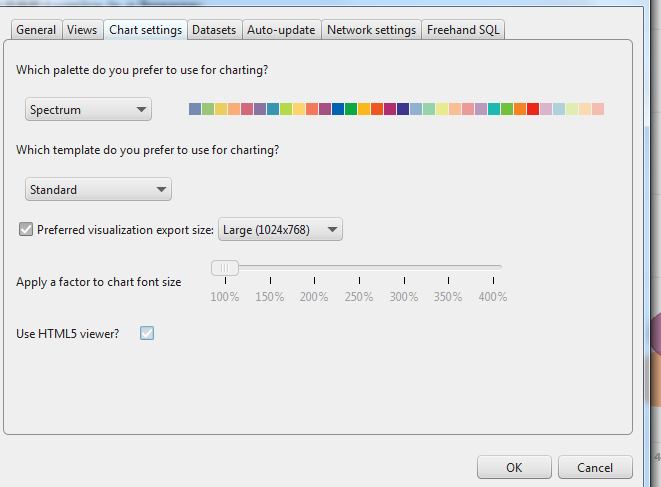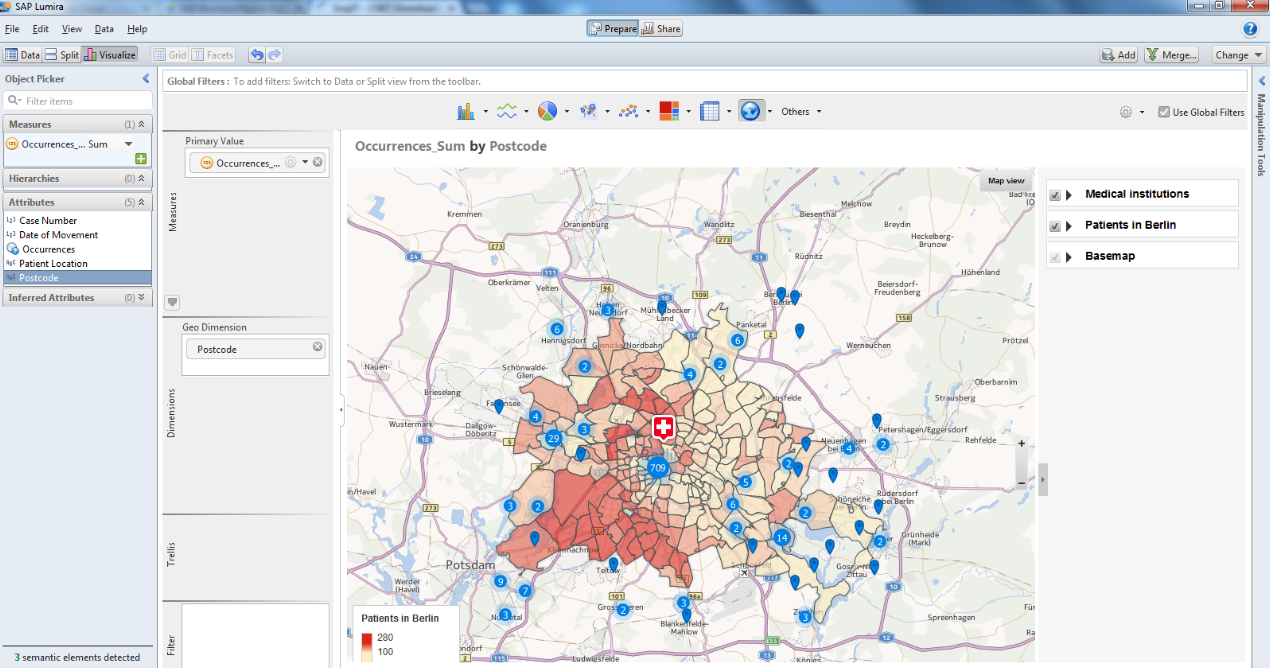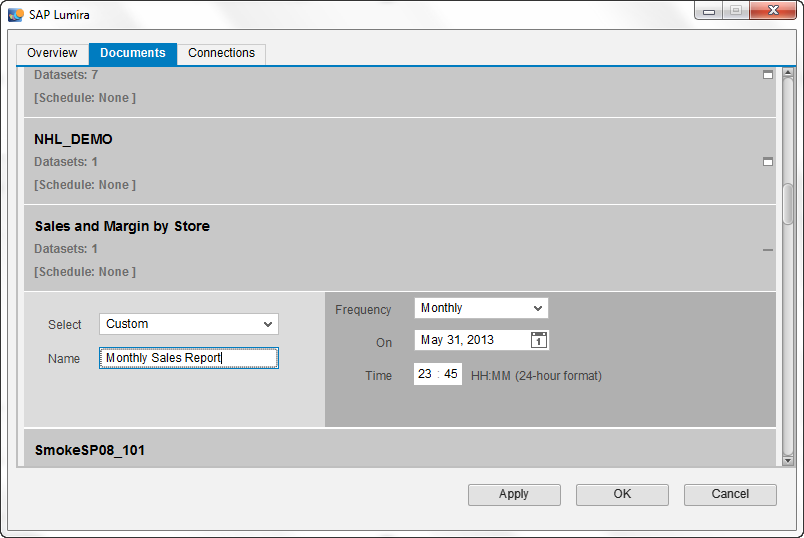
- SAP Community
- Products and Technology
- Technology
- Technology Blogs by SAP
- SAP Lumira 1.0 SP11 – New features at a glance par...
- Subscribe to RSS Feed
- Mark as New
- Mark as Read
- Bookmark
- Subscribe
- Printer Friendly Page
- Report Inappropriate Content
SAP Lumira 1.0 SP11 – New features at a glance part 2
By Manikandan Srinivasan, Andreas Krause and John Mrozek.
Part 2 highlighting some of the planned new features in the soon to be released SP11 Lumira Desktop.
5. Visualization Extensions
CVOM - which is also referred to as SAP HTML5 Visualization, powered by CVOM - is a visualization engine designed to work with HTML5 technology to create different visualizations. CVOM (Common Visual Object Modeler) also provides the ability to help partners and developers to build their own visualizations in SAP Lumira.
Steps to deploy sample custom charts that are packaged with SAP Lumira:
Sample custom charts are installed with SAP Lumira in the following folder: \<SAP Lumira Install>\Desktop\Samples
The sample viz.ext.flagbar must be used with its own shipped data set, as it can not be exploited correctly using other data. It is only an example to show
the possibilities of the type of chart. Ensure that you acquire the data from the following data source when using this chart: \<SAP Lumira Install>\Desktop\chartExtensions\viz.ext.flagbar\examples\sampledata\sampledata_flagbar.xls
- Close SAP Lumira.
- Go to the folder: \<SAP Lumira Install>\Desktop\Samples\.
The following folders are installed with the application. These folders contain the javascript CVOM chart extensions, datasource, manifest file, and the chart feed definition:
• viz.ext.flagbar
• viz.ext.samplesbar
Note: See Related Topics for a description of the files in each folder, and how you can use the sample chart extensions to build new custom charts.
3. Copy the sample folders to the following folder: \<SAP Lumira Install>\Desktop\ChartExtensions\.
4. Restart SAP Lumira.
5. Select File > Preferences, and then click the Chart Settings tab.
6. Select the Use HTML5 viewer ? check box and then click OK.

The sample custom charts appear in the new family E in the chart bar.

Example of a custom geo map below:

6. SAP Lumira Cloud Integration:
Sharing Lumira .svid documents with others via the Lumira Cloud
Lumira Cloud enables sharing captivating discoveries with colleagues.
- I have my document and select File | Save As.

- Now select the Save to SAP Lumira Cloud option. Here you can share with other users and give them different access levels.

- The content is now available for consumption and further analysis in the SAP Lumira Cloud section of the SAP Lumira desktop application.

Publish SAP Lumira Datasets to SAP Lumira Cloud
With SAP Lumira you can easily mash-up multiple datasources such as an excel spreadsheet and a universe. You can then publish them to the cloud for future analysis. In this example, I am just using a single HANA Calculation View.
- I select my dataset and choose the Publish to Lumira Cloud option.

- I then login with my email address.

3.Next I give information about my dataset.

4) The Dataset is now published to SAP Lumira Cloud.
Explore Datasets that have been published to SAP Lumira Cloud
- I log in @http://cloud.saplumira.com and see the published dataset. I click on the name of the dataset and am presented this view where I can explore and analyze the data & I can quickly, visually see how each state performed by year.

Scheduling of refresh documents with optional publication to Lumira
- In File | Preferences, select the Enable SAP Lumira Agent option. You’ll need to close and then re-launch Lumira Desktop.

2. You will now see a Lumira Agent icon. It will remain even if you close SAP Lumira Desktop.

3. Right click on the icon and select Open SAP Lumira Agent.

4. Save the username and password for connections that are used by the documents you want to schedule in the Connections tab. This information only needs to be entered once.

5. Set the frequency and other information and the report will now be scheduled.

6. The documents are updated based on a refresh of the datasource on both the Desktop and in the Cloud.
- SAP Managed Tags:
- SAP Lumira
You must be a registered user to add a comment. If you've already registered, sign in. Otherwise, register and sign in.
-
ABAP CDS Views - CDC (Change Data Capture)
2 -
AI
1 -
Analyze Workload Data
1 -
BTP
1 -
Business and IT Integration
2 -
Business application stu
1 -
Business Technology Platform
1 -
Business Trends
1,661 -
Business Trends
86 -
CAP
1 -
cf
1 -
Cloud Foundry
1 -
Confluent
1 -
Customer COE Basics and Fundamentals
1 -
Customer COE Latest and Greatest
3 -
Customer Data Browser app
1 -
Data Analysis Tool
1 -
data migration
1 -
data transfer
1 -
Datasphere
2 -
Event Information
1,400 -
Event Information
64 -
Expert
1 -
Expert Insights
178 -
Expert Insights
270 -
General
1 -
Google cloud
1 -
Google Next'24
1 -
Kafka
1 -
Life at SAP
784 -
Life at SAP
11 -
Migrate your Data App
1 -
MTA
1 -
Network Performance Analysis
1 -
NodeJS
1 -
PDF
1 -
POC
1 -
Product Updates
4,578 -
Product Updates
323 -
Replication Flow
1 -
RisewithSAP
1 -
SAP BTP
1 -
SAP BTP Cloud Foundry
1 -
SAP Cloud ALM
1 -
SAP Cloud Application Programming Model
1 -
SAP Datasphere
2 -
SAP S4HANA Cloud
1 -
SAP S4HANA Migration Cockpit
1 -
Technology Updates
6,886 -
Technology Updates
395 -
Workload Fluctuations
1
- ABAP Matrix (AFM/ALM) in Technology Blogs by Members
- User Experience Advances with SAP S/4HANA 2023 FPS01 (Private Cloud and On-Premise) in Technology Blogs by SAP
- Terraform Provider for SAP BTP version 1.1.0 - what’s new in Technology Blogs by SAP
- OUT NOW: SAP Signavio February 2024 release in Technology Blogs by SAP
- Unleashing the Power of SAP S/4HANA Public Cloud: A Dive into Analytics Capabilities in Technology Blogs by SAP
| User | Count |
|---|---|
| 11 | |
| 10 | |
| 10 | |
| 9 | |
| 8 | |
| 7 | |
| 7 | |
| 7 | |
| 7 | |
| 6 |